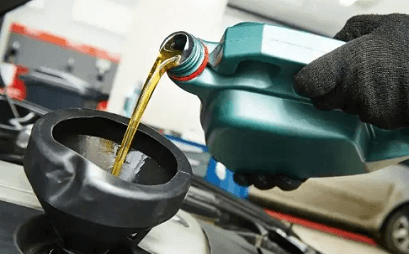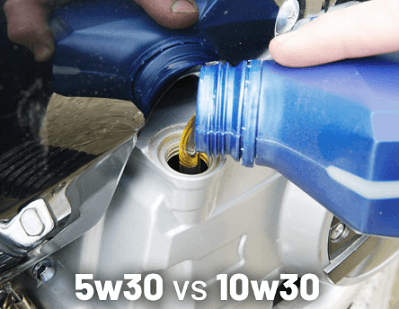mix 5W-30 with 10W-30 oilth 10W-30 to top up your engine oil. Introduction (122 words): Choosing the right engine oil for your vehicle is crucial for optimal performance and protection.
emphasize the need to change the engine oiled to top up your engine oil and realize you have different viscosities on hand. The question then arises: Can you mix 5W-30 with 10W-30? Thankfully, the answer is yes. Both of these oils fall within the same viscosity range, with 5W-30 being slightly thinner than 10W-30.
Mixing them won’t cause any severe damage to your engine as long as you only use it for a top-up and don’t run your engine solely on the mixed oil. It’s important to note, however, that sticking to the manufacturer’s recommended oil viscosity is still the best choice for maintaining your engine’s longevity.
The Basics Of Engine Oil Types
Differentiating between 5W-30 and 10W-30
Engine oil plays a crucial role in maintaining the performance and longevity of your vehicle’s engine. One important aspect to understand is the difference between oil viscosity grades such as 5W-30 and 10W-30.
Viscosity is the measure of a fluid’s resistance to flow, and it’s represented by two numbers with a “W” in between. The first number, such as 5W or 10W, indicates the oil’s flowability in cold temperatures. The lower the number, the better it performs in cold weather.
The second number, which is 30 in both cases, represents the oil’s viscosity at operating temperatures. Higher numbers indicate thicker oil, while lower numbers indicate thinner oil.
| 5W-30 | 10W-30 |
|---|---|
| Provides better cold start protection due to its lower cold temperature viscosity. | Slightly thicker than 5W-30 at operating temperatures, offering better high-temperature protection. |
| Commonly recommended for vehicles operating in colder climates or during colder months. | Recommended for vehicles in warmer climates or for summer driving. |
| Offers improved fuel efficiency due to its lighter viscosity. | Provides better protection against engine wear and tear under high temperatures. |
Remember, it’s essential to follow your vehicle manufacturer’s recommendations for oil viscosity to ensure optimal performance and engine protection. Mixing different viscosity oils may affect the desired performance characteristics, so it’s generally advised to stick to the recommended oil grade.
Compatibility Of 5w-30 And 10w-30
Compatibility of 5W-30 and 10W-30
When it comes to mixing 5W-30 and 10W-30 oils, it is important to understand their similarities and differences. Both oils are multi-grade and commonly used in various vehicles. These oils have the same viscosity at operating temperatures, which means they provide similar protection to the engine.
However, mixing these oils can potentially cause issues. The most important factor to consider before mixing is the vehicle manufacturer’s recommendation. Mixing different oils could void the vehicle warranty, and it may affect the engine performance.
Additionally, mixing oils with different additive packages could lead to compatibility issues. Each oil brand has its own unique additives, and when combined, they could interact in unpredictable ways, potentially reducing the effectiveness of the additives.
In conclusion, while it is technically possible to mix 5W-30 and 10W-30 oils, it is generally recommended to avoid mixing them unless directed by the vehicle manufacturer. It’s crucial to consult the owner’s manual or a professional mechanic before making any decisions regarding oil mixing.
Benefits Of Mixing 5w-30 And 10w-30
Mixing 5W-30 and 10W-30 oils can provide several benefits for your engine. Firstly, this combination enhances performance and fuel efficiency. The blend of these viscosities allows for better lubrication in different engine conditions, ensuring smoother operation and improved overall performance.
Another advantage of mixing these oils is improved cold-start capabilities. The 5W-30 oil provides excellent fluidity during low temperatures, making it easier to start the engine in chilly weather. The addition of 10W-30 further enhances this property, ensuring a smoother start every time.
Furthermore, this mixture offers engine protection under extreme temperatures. 10W-30 oiloil provides protection at high temperatures, while the 10W-30 oil maintains viscosity stability even in hotter conditions. The combination ensures your engine remains well-protected and minimizes wear and tear.
Performance And Engine Compatibility
Mixing different grades of oil, such as 5W-30 and 10W-30, can have an impact on engine performance. It is important to understand the compatibility of these oils with your engine to ensure optimal performance and longevity.
While mixing different grades of oil may be acceptable in certain circumstances, it is generally recommended to use the oil viscosity specified by the manufacturer for your specific engine. Older engines may be more tolerant of oil viscosity variations, while newer engines with more precise specifications may require specific oil grades for optimal performance.
To determine the compatibility of different oil grades, it is essential to consult the manufacturer’s recommendations and guidelines. The manufacturer’s specifications provide important insights into the suitable oil grades to use for your engine. Following these recommendations helps to ensure that the oil you choose provides the necessary protection and performance for your engine.
Correct Mixing Procedures
When considering mixing 5W-30 with 10W-30 oils, it is essential to follow best practices to ensure safe and effective results. Firstly, it is important to note that mixing oils of different viscosities can alter their performance characteristics. However, according to professional opinions and advice, mixing these two specific grades of oil should not have any adverse effects on your engine.
To properly mix 5W-30 with 10W-30, start by draining the existing oil from the engine. Dispose of the used oil appropriately, as proper oil disposal is of utmost importance to prevent harm to the environment. Once the old oil is drained, replace it with a blend of 5W-30 and 10W-30 oil in the desired ratio, which is usually a 50:50 mix. This mixture will help to maintain adequate lubrication under different temperature conditions.
In summary, as long as the oils are compatible, blending 5W-30 with 10W-30 can be done following these correct mixing procedures. Always consult professionals or refer to manufacturer guidelines for specific recommendations based on your engine’s requirements.
Table: Mixing Ratios
| Oil Grade | Ratio |
|---|---|
| 5W-30 | 50% |
| 10W-30 | 50% |
Potential Risks And Drawbacks
Can I Mix 5W-30 With 10W-30
Potential Risks and Drawbacks
Mixing different viscosities of engine oil, such as 5W-30 and 10W-30, can have negative effects on engine longevity and performance.
The varying thicknesses of the oil may not provide the necessary lubrication for optimal engine operation, potentially causing increased wear and tear on engine components. Furthermore, the different additive packages in each oil type may not work well together, resulting in reduced overall oil performance.
Mixing oils could also affect warranty implications and raise concerns with manufacturers. If engine damage occurs due to mixtures, it may void the warranty, leaving the vehicle owner responsible for repair costs.
Precautions to take when mixing
If you must mix oils, it is advisable to consult the vehicle manufacturer or a knowledgeable mechanic for guidance. They can offer specific recommendations and advice based on your vehicle’s needs. It is essential to carefully read and follow the manufacturer’s guidelines and instructions to minimize potential risks associated with mixing viscosities.

| Precautions to Take when Mixing |
|---|
| Consult vehicle manufacturer or mechanic for guidance |
| Carefully read and follow manufacturer’s guidelines |
Other Considerations When Mixing
Other Considerations when Mixing
When considering whether to mix 5W-30 and 10W-30 oils, there are a few other factors to take into account.
Weather and climate factors: It’s important to consider the weather conditions in your area. If you live in a region with extreme temperature variations, such as cold winters and hot summers, it’s recommended to use a thinner oil during colder months to ensure proper lubrication. However, if you live in a consistently mild climate, mixing these oils may have less impact on performance.
Driving conditions and habits: Your driving habits and conditions can also affect the performance of mixed oils. If you frequently engage in stop-and-go driving or drive in high-stress situations, a heavier oil may be more suitable. On the other hand, if you have a more relaxed driving style, a thinner oil may suffice.
Maintenance and oil change schedules: It’s crucial to follow the manufacturer’s recommendations for oil change intervals. Mixing oils should not be used as a substitute for regular maintenance. Stick to a consistent oil change schedule and ensure that the mixed oils meet the required specifications.
Expert Opinions On Mixing 5w-30 And 10w-30
Insights from industry professionals: Mixing 5W-30 and 10W-30 motor oils can be a topic of debate among automotive experts. While some professionals claim that mixing these two oils is generally acceptable, others advise against it. The primary concern is that mixing oils with different viscosity grades may affect the overall performance and functionality of the engine.
Perspectives from automotive experts: Some experts argue that minor mixing in emergencies, such as running low on one type of oil, won’t cause major damage. However, they emphasize the need to change the engine oil as soon as possible to maintain optimal performance. It is important to note that mixing oils can potentially alter the viscosity and reduce the oil’s ability to provide proper lubrication and protection.
Real-life experiences and case studies: Many individuals have shared their experiences with mixing 5W-30 and 10W-30 oils. Some have reported no issues, while others have encountered engine malfunctions or reduced performance. It’s crucial to consider the manufacturer’s recommendations and consult a professional before mixing oils. A table summarizing the main points covered:
| Pros | Cons |
|---|---|
| Can be acceptable in certain emergencies | Potential viscosity alteration |
| No immediate damage reported in some cases | Possible reduced engine performance |
Frequently Asked Questions For Can I Mix 5w-30 With 10w-30
Can I Mix 5w-30 With 10w-30?
Yes, you can mix 5W-30 with 10W-30 oil in certain situations. Both oils have similar viscosity and are compatible. However, it’s important to consider the manufacturer’s recommendations and the climate in which you’ll be driving. Mixing oils is typically done as a temporary solution, and it’s best to consult a professional for thorough guidance.
Conclusion
So, can you mix 5W-30 with 10W-30? The answer is yes, you can. Both oils have the same base viscosity and are compatible with each other. However, it’s important to consider the specific needs of your vehicle and follow the manufacturer’s recommendations.
Mixing oils may affect the performance and longevity of your engine, so it’s always best to consult with a professional if you have any doubts. Remember, maintaining your engine’s health is crucial for its long-term functionality.


Leave a Reply